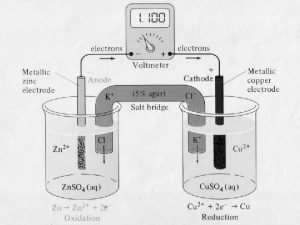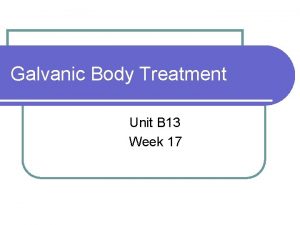Galvanic Skin Response To understand how GSR works

















- Slides: 17

Galvanic Skin Response To understand how GSR works, take a quick step back and have a look at the physiological characteristics of the largest organ of the human body - the skin. Our skin functions as the principal interface between organism and environment. Together with other organs, it is responsible for bodily processes such as the immune system, thermo-regulation, and sensory-motor exploration: Immune System As protective barrier, the skin separates our body from the environment and its threats mechanical impacts and pressure, variations in temperature, micro- organisms, radiation, and chemical agents. (Thermo-)Regulation The skin controls body temperature by regulating sweat emission, piloerection (“goosebumps”), and peripheral blood circulation. Sensing and Perception The skin is an organ of perception. It contains an extensive network of nerve cells that detect and relay changes in the environment based on the activity of receptors for temperature, pressure, and pain.

Consistent with this complexity of function, the skin has three primary layers: 1 Epidermis (outmost protective layer) 2 Dermis (cushion for the body from stress and strain) 3 Hypodermis (anchor to bones and muscles)

Our body has about three million sweat glands. The density of sweat glands varies markedly across the body, being highest on the forehead and cheeks, the palms and fingers as well as on the sole of the feet. Whenever sweat glands are triggered and become more active, they secrete moisture through pores towards the skin surface. By changing the balance of positive and negative ions in the secreted fluid, electrical current flows more readily, resulting in measurable changes in skin conductance (increased skin conductance = decreased skin resistance). This change in skin conductance is generally termed Galvanic Skin Response (GSR) reflects the variation in the electrical characteristics of the skin. GSR is also known as Skin Conductance (SC), Electrodermal Activity (EDA), Electrodermal Response (EDR), and Psychogalvanic Reflex (PGR). GSR activity is typically measured in “micro-Siemens (u. S)” or “micro-Mho (u. M)”, mirroring the conductance of a certain material.

Psychological studies utilize GSR to identify how humans respond emotionally towards various stimuli and how these responses are affected by stimulus properties (color, shape, duration of presentation), personality characteristics (extraverts vs. introverts), social expectancies (“men are not afraid of the dark!”), and individual learning histories. Think of this: A terrifying encounter with the neighbor’s vicious dog in your childhood certainly triggers autonomous arousal and increased sweating when you come face to face with dogs in later life (perhaps even an image of a dog is enough to give you the creeps).

The logic behind GSR is very simple: 1 Place two electrodes on emotionally sensitive locations on the body 2 Apply a low constant voltage 3 Measure the voltage difference between the two electrodes 4 Report the associated skin conductance

Sensor placement 1 To guarantee accurate biometric measurements, the sensors need to be connected to the skin at all times throughout the experiment. Ensure the sensors are placed snugly on the fingers or foot without being too firm as this deteriorates data quality.

2 Consider using adhesive electrode pads that are already filled with conductive gel in order to reduce preparation time and to avoid electrode movement. 3 Spare yourself unpleasant surprises and be consistent with sensor placement across all respondents. Use the same recording site for the entire study, and do not switch locations during or between recordings. 4 Normally you don’t need to pretreat recording sites. However, if a respondent has extremely oily skin, you might be better off cleaning the skin surface below the electrodes with an alcohol swab (70% isopropanol, available at drug stores) in order to improve sensor stability.

Instruct respondents properly to minimize artifacts • • Breathe normally Keep limb movements at a minimum Try to not talk Sit comfortably during stationary studies in lab environments



Analyzing GSR data 1 Latency 2 Peak amplitude 3 Rise time 4 Recovery time The duration from stimulus onset to the onset of the phasic burst


Block Diagram

A polygraph, popularly referred to as a lie detector (test), is a device or procedure that measures and records several physiological indicators such as blood pressure, pulse, respiration, and skin conductivity while a person is asked answers a series of questions



• Study Until page 39 in book
 To understand recursion you must understand recursion
To understand recursion you must understand recursion Milady chapter 23
Milady chapter 23 Stratum granulosum
Stratum granulosum Thin skin vs thick skin
Thin skin vs thick skin Traffic management
Traffic management Paul direc
Paul direc Gsr part 1
Gsr part 1 Introduction for portfolio in math
Introduction for portfolio in math Gsr part 7
Gsr part 7 Integrated management systems training north america
Integrated management systems training north america Iaea gsr part 7
Iaea gsr part 7 Enunciado gsa
Enunciado gsa Gsr
Gsr Part5ds
Part5ds Concentration cell
Concentration cell Difference between galvanic cell and electrolytic cell
Difference between galvanic cell and electrolytic cell Anode cathode reduction oxidation
Anode cathode reduction oxidation Aftercare advice for galvanic body treatment
Aftercare advice for galvanic body treatment

































